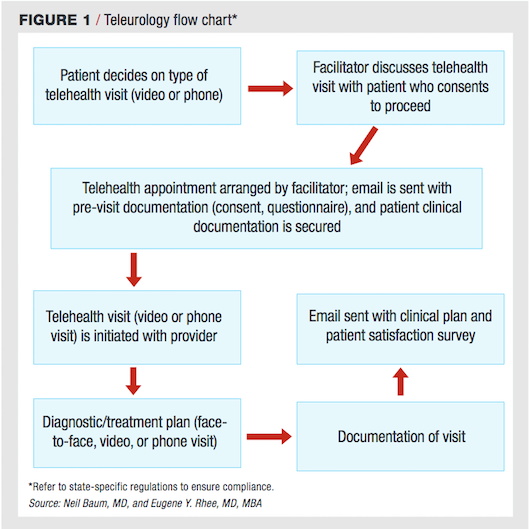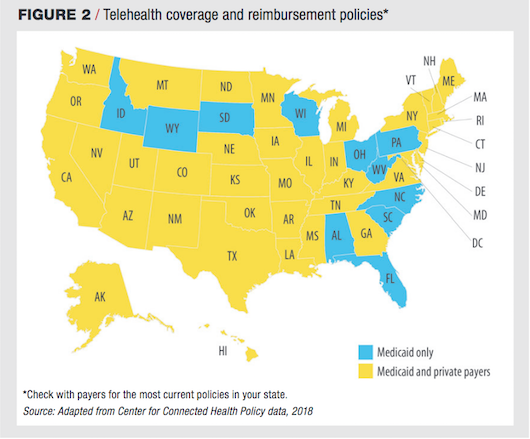Teleurology: The time has arrived
This article will discuss obstacles that urologists typically must address when implementing telemedicine into their practice.
Elnur - stock.adobe.com

Mahatma Gandhi once said, “First they ignore you, then they laugh at you, then they fight you. Then you win.”
Although telemedicine has been part of the health care system for nearly 20 years, many physicians have been resistant to its adoption as they face various barriers in implementation, including the unfamiliarity of digital technology, equipment costs, logistical office challenges, and navigating regulatory constraints and reimbursement restrictions.
This article will discuss obstacles that urologists typically must address when implementing telemedicine into their practice. We will also address initial steps urologists looking to incorporate telemedicine should take as well as the potential return on investment from implementing telemedicine into existing practices.
In a busy urology practice, inevitably certain patients do not necessitate an in-person visit for effective urologic care. Imagine an afternoon clinic with 30 patients; how many of those patients need a physical exam for effective care? Do the four men scheduled for annual PSA surveillance need a digital rectal exams at each visit? Do the three men with BPH presenting for symptom check need a live visit to refill their alpha-blocker prescription? Do the three women on anticholinergics for overactive bladder (OAB) need a face-to-face encounter to get their medication?
And do the three men taking testosterone self-injections need to be seen live for symptom assessment and PSA testing? Or, alternatively, can the urologist safely, efficiently, and effectively manage these 13 patients utilizing teleurology?
Removing the barriers
Urologists have always been at the forefront of technological advances for diagnosis and treatment of disease. Urologists were early adopters of robotic surgery, minimally invasive laser treatment, and enhanced imaging techniques. While urology has been progressive in the adoption of new technologies, the medical field as a whole generally lags behind other industries like finance, hospitality, real estate, retail, and even dentistry in utilizing technology.
Also see: Losing patients to follow-up? Here’s what you can do
That point is illustrated simply by the fact that most medical offices still rely on fax machines to receive results, CDs to transmit images, and phone calls to make appointments. Telemedicine is a technology available to most physicians that can enhance the doctor-patient interaction, yet it is not yet widely used in urology. Technology and connectivity can be an important resource for patient care, rather than an obstacle, especially when the barriers to implementation are overcome. As doctors increase their utilization of telemedicine, obstacles they face include reluctance to forego a face-to-face encounter, legal liability of deferring a physical examination, and the potential for no, or reduced, reimbursement.
Addressing each of these barriers takes time and effort but adoption of a telemedicine practice can be achieved with the right resources and open mindedness.
While adopting a tele-practice may take clinicians out of the comfort zone of their office, realizing that a televisit is an extension of practice rather than a replacement helps alleviate the potentially unsettling feeling of sitting behind a computer during a patient encounter. The legal ramifications of telemedicine must be considered when adopting a tele-practice, and urologists considering telemedicine should seek legal advice before doing so. Issues that may need to be addressed include: state licensing requirements, confirming malpractice coverage, state prescription requirements and restrictions, and establishing informed patient consent.
Urologists should also be attentive to state-specific limitations on reimbursement for televists. Nationally, reimbursement for televisits is gradually expanding. Currently nearly every state has legislation that allows physicians to be reimbursed through Medicaid for remote consults. Furthermore, Medicare advantage patients will be covered for televisits as part of their core benefits starting in 2020.
Next: Which patients can be managed with teleurology?Which patients can be managed with teleurology?
While not all urology patients are appropriate candidates for televisits, certain diseases processes lend themselves well for virtual encounters. Examples of patient visits appropriate for teleurology may include symptom checks for men with BPH or ED, patients with OAB and incontinence, discussions regarding elevated PSA, uncomplicated UTI treatment, hypoandrogenism follow-up, and prescription refills (eg, alpha-blockers, phosphodiesterase type-5 inhibitors, anticholinergics, or pentosan polysulfate sodium [Elmiron]). (For a graphic showing a typical teleurology work flow, see figure 1.)

Other patients that may be considered for teleurology include postoperative patients, those living in rural areas with limited access to urologic care, patients managed with indwelling catheter exchanged by home health providers, and those on active surveillance/watchful waiting for prostate cancer. Further areas of opportunity amenable to teleurology might include home sterility testing in post-vasectomy patients, bladder cancer follow-up, and infertility evaluations.
Let’s look at a hypothetical scenario of a patient followed by teleurology. A 65-year-old man has BPH and ED. His digital rectal exam is normal and his PSA has been <1.0 ng/mL for 3 years. He has a history of elevated cholesterol and hypertension. His medications include sildenafil, tamsulosin, and telmisartan. There have been no changes in his lower tract urinary symptoms and the sildenafil is helpful for his ED.
Read: What’s your biggest frustration with prior authorization?
The patient uses an app to monitor his blood pressure and flow rate. He goes to his local laboratory for PSA and cholesterol testing, and the results are sent to his primary care doctor and urologist. He completes an online health questionnaire, AUA Symptom Score, and a voiding diary, all of which show no changes in the past year. He has been refilling his sildenafil and tamsulosin prescriptions online for the past 2 years and receives a daily Apple Watch reminder to take his medication.
Under these circumstances, it would be appropriate for the urologist to review the blood work and AUA Symptom Score, and have a 5-minute teleurology visit at a time convenient for doctor and patient. The urologist would be compensated by the insurance company or out of pocket by the patient for the visit. This scenario benefits the patient by reducing lost travel time and the hassle for some patients of an office visit but also benefits the doctor by promoting efficiency, the practice by potentially reducing overhead, and the payer by more efficiently managing the patient’s various health issues-a win all around!
Regulation and reimbursement
Today’s patients, especially millennials, are looking for access and convenience, making telemedicine an attractive patient care option. Patients are joining higher-deductible plans with higher co-pays and increased out-of-pocket costs. Previously, the idea of charging patients out of pocket would have been laughable. For those with insurance, coverage was broad and copays were minimal or nonexistent. Now, however, there is an ongoing shift toward higher deductibles, more coinsurance, and increased out-of-pocket costs.
In the current climate, a typical copay for a primary care visit ranges from $20 to $40, while the copay for a specialist visit can be $30 to $50 and $30-$80 for a urology visit, according to Investopedia (bit.ly/copayarticle). With that in mind, if you can make teleurology services available for between $40 and $80 per encounter, you will become an attractive option to a large segment of patients who can avoid their insurance by paying the equivalent of a copay in a single out-of-pocket payment. If you can conduct three to five teleurology visits per hour, implementing teleurology may be in the best fiscal interest of your practice.
Additionally, while you may not be seeing Medicaid patients currently, new Medicaid laws and initiatives might mean that adding these patients to your practice via a virtual platform may be fiscally advantageous. This strategy can also rid practices of the paperwork and bureaucracy of dealing with insurance companies over reimbursement claims, providing tangible monetary benefits. Lastly, practices offering such a service may be attractive to uninsured patients who depend on transparent and reasonable service pricing.

Reimbursement currently varies among payers and states (figure 2). An excellent resource is provided by a national telehealth policy resource center, The Center for Connected Health Policy (bit.ly/CCHPresource), a nonprofit, nonpartisan organization working to maximize telehealth’s ability to improve health outcomes, care delivery and cost effectiveness.
It is critical to check with payers in your catchment area to be certain they will compensate you for conducting a teleurology service.
Private insurers. In the current climate, more than half of all states have telemedicine “parity” laws in place. According to the American Telemedicine Association, parity laws require insurers to reimburse a telemedicine service as they would a face-to-face visit. It is crucial to understand your states parity law prior to determining which patients might benefit from a teleurology visit.
Medicare. Historically, Medicare telemedicine reimbursement policies have been stifling at best. Unless seeing patients living in rural areas at a designated telehealth location for a select list of services, you would almost certainly not be collecting money from Medicare for telemedicine. This will be changing, at least in part, with a new CMS rule expanding telehealth coverage to Medicare Advantage patients. Beginning in 2020, virtual visits will be a core benefit covered by CMS. This will significantly expand the number of patients who have coverage for televisits, as 34% of Medicare patients are enrolled in Medicare advantage, according to the 2019 Kaiser Family Foundation Analysis of CMS State/Country Market Penetration Files, 2019.
Medicaid. Medicaid programs, on the other hand, have historically been more progressive. The American Telemedicine Association and Center for Connected Health Policy publish state-specific Medicaid coverage. On the whole, 48 states provide some type of Medicaid coverage for telemedicine. While details vary by jurisdiction, policies are typically more permissive than those of Medicare; 36 state Medicaid programs, for instance, permit patients to participate in telemedicine visits from their homes.
Next: Other benefits of teleurologyOther benefits of teleurology
Among its other benefits, telemedicine has been shown to overcome barriers to health services caused by the distance between patient and provider. It addresses issues surrounding access to reliable transportation, fragmentation of care due to gaps in time between appointments, and lack of available providers (table). For physicians, teleurology can improve job satisfaction by providing more efficient and reimbursable care with improved work-life balance.

Before implementing teleurology in your practice, you must determine state-level legal constraints, medical license requirements, malpractice coverage, and reimbursement restrictions.
Conclusion
New technology is providing new ways for urologists to provide improved services with better access to their patients. By using video to see patients, urologists can improve their patients’ engagement, monitor their wellness, and save time and money.
Are you using telemedicine? Tell us your experience by emailing us at urology_times@mmhgroup.com

Neil Baum, MD

Eric Kirshenbaum, MD

Eugene Y. Rhee, MD, MBA
Dr. Baum is professor of clinical urology at Tulane Medical School, New Orleans, Dr. Kirshenbaum is a reconstructive urology fellow at Loyola University Medical Center, Maywood, IL, and Dr. Rhee is regional chief of urology for Kaiser Permanente/Southern California, chair-elect of the AUA Public Policy Council, and co-chair of the AUA Telehealth Taskforce.

James M. Hotaling, MD, MS

Steven A. Kaplan, MD
Section Editors James M. Hotaling, MD, is assistant professor of surgery (urology) at the Center for Reconstructive Urology and Men’s Health, University of Utah, Salt Lake City, and Steven A. Kaplan, MD, is professor of urology, Icahn School of Medicine at Mount Sinai, New York.

Potential code for prior authorizations on AMA CPT Editorial Panel meeting agenda
March 28th 2024"Good public and economic policy must align costs, benefits, and incentives; currently, all costs are incurred by physician practices, and all financial savings and benefits from prior authorization accrue to health insurance plans, leading to perverse incentives,” says Alex Shteynshlyuger, MD.
